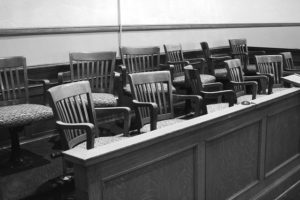Keys to an Effective Voir Dire
As law students learn from their textbooks, “voir dire” comes from Old French and means “to speak the truth.” And as they learn from courses and colleagues, the point of voir dire is to find out if prospective jurors harbor a fixed bias against one’s client. Those notions are incredibly consistent with what we, as trial consultants, are trying to achieve. However, once in practice, attorneys are often taught that jury selection is a great time to begin “priming” jurors to their case. And fears about “poisoning the panel” creep in and make attorneys hesitant to actually allow jurors to speak the truth. Both of these practices—while common—tend to inhibit the usefulness of voir dire.
In our ideal jury selection, 1) attorneys focus less on argument and more on listening to the jurors and 2) jurors are encouraged to speak freely even—in fact, especially—if their opinions are counter to our case. To the first point, we understand the fear of waiting to argue your case—and agree that there is some vital information you should impart during voir dire. But the primary voir dire goal should always be collecting information rather than providing it. When faced with presenting potential jurors with the best parts of your case or getting reactions to the worst parts, the latter is much more valuable.
It is a difficult mental shift to incorporate a few case themes into voir dire questions while leaving the remaining arguments for openings. And it is even more difficult, we grant, to be comfortable with encouraging jurors to speak freely. Almost instinctively, attorneys want to stop—and correct—jurors who express negative opinions about their client or case. In fact, voir dire questions are often designed to force an agreement: “Don’t you think that…?” Or, when a juror begins to express a contrary opinion, they are interrupted and corrected: “But wouldn’t you agree that…?”
Some negative opinions do need to be handled privately, such as extreme, case-specific opinions (“My mom took that drug and has never been the same”). But it is vitally important to allow—and even encourage—jurors to express general, negative opinions about your case or client (“I don’t think drug companies care about people; I think they hide the dangers of drugs”). By expressing those opinions, jurors are not only identifying themselves as receptive to your opponent, but they are providing the opportunity to identify other jurors who share their views, but who would not have spoken up on their own (“Mrs. X believes that drug companies don’t care about safety—only money. Are there others who feel that way?”).
We recognize that allowing such public expressions of negative opinions about your case can be frightening. In fact, many attorneys have been taught that doing so is tantamount to endorsing the opposing themes or allowing jurors to “contaminate the panel.” But jurors’ opinions and belief systems are built on a lifetime of experiences and are therefore, deeply entrenched. They are extremely unlikely to be influenced or swayed by comments from other jurors during voir dire—or by a few weeks of argument during trial. This mental rigidity makes it imperative that opposing jurors feel comfortable enough during voir dire to identify themselves, so they can be removed.
There’s an oft-repeated adage that trials are won in jury selection. Although we believe that it takes a lot more than a great jury selection to be successful at trial, trials can definitely be lost during jury selection. Voir dire provides your one chance to listen to jurors before the verdict. And if they have negative opinions or beliefs about your client, it’s much better to hear those opinions during jury selection than when the verdict is read.
______________________
Tracey Carpenter, Ph.D. and Susan Chiasson, Ph.D. started Carpenter Trial Consulting in 2010. They each have extensive experience in high-stakes civil litigation and specialized expertise in how jurors analyze evidence, assess witnesses, and arrive at verdict decisions.
